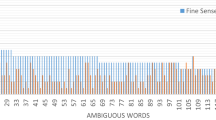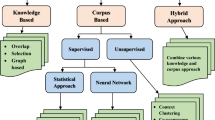Abstract
Word sense disambiguation (WSD) identifies the right meaning of the word in the given context. It is an indispensable and critical application for all the natural language processing tasks. In this paper, two deep learning techniques multilayer perceptron and long short-term memory (LSTM) have been individually inspected on the word vectors of 66 ambiguous Punjabi nouns for an explicit WSD system of Punjabi language. The inputs to the deep learning techniques are the simple word vectors derived directly from manually sense-tagged corpus of Punjabi language. The multilayer perceptron has outperformed the LSTM deep learning technique for WSD task of Punjabi language. Six traditional supervised machine learning techniques have also been tested on same dataset using unigram and bigram feature sets. A comparison between deep learning techniques and traditional six supervised machine learning techniques clearly indicates that the deep learning techniques using simple word vectors outperforms the earlier techniques.






Similar content being viewed by others
References
Navigli R (2009) Word sense disambiguation: a survey. ACM Comput Surv 41:1–69
Vidhu Bhala R, Abirami S (2014) Trends in word sense disambiguation. Artif Intell Rev 42:159–171
Azzini A, Pereira CDC, Dragoni M, Tettamanzi AGB (2008) Evolving neural networks for word sense disambiguation. IEEE Eighth Int Conf Hybrid Intell Syst Barcelona 2008:332–337
Manning CD (2016) Computational linguistics and deep learning. Comput Linguist 41(4):701–707
Severyn A, Moschitti A (2015) Twitter sentiment analysis with deep convolutional neural networks. In ACM: Proceedings of the 38th international ACM SIGIR conference on research and development in information retrieval, Santiago, Chile, pp 959–962
Deng LAO (2013) Recent advances in deep learning for speech research at Microsoft. In: 2013 IEEE international conference on IEEE acoustics, speech and signal processing (ICASSP), pp 8604–8608
Khademian Mahdi, Homayounpour Mohammad Mehdi (2017) Feature joint-state posterior estimation in factorial speech processing models using deep neural networks. Comput Electr Eng 62:574–587
LeCun Y, Bengio Y, Hinton G (2015) Deep learning. Nature 521:436–444
Uddin MZ, Hassan MM, Almogren A, Zuair M, Fortino G, Torresen J (2017) A facial expression recognition system using robust face features from depth videos and deep learning. Comput Electr Eng 63:114–125
Deselaers T, Hasan S, Bender O, Ney H (2009) A deep learning approach to machine transliteration. In Association for computational linguistics: proceedings of the fourth workshop on statistical machine translation, Athens, Greece, pp 233–241
Veronis, JI, Nancy M (1990) Word sense disambiguation with very large neural networks extracted from machine readable dictionaries. In: Proceedings of the 13th conference on computational linguistics-volume 2, Stockholm
Mooney R (1996) Comparative experiments on disambiguating word senses: an illustration of the role of bias in machine learning. arXiv preprint cmp-lg/9612001, pp 1–10
Zuppann A (2003) A connectionist approach to word sense disambiguation. In: Class of 2003 senior conference on natural language processing, Swarthmore
Lu Z, Liu T, Li S (2004) Combining neural networks and statistics for chinese word sense disambiguation. In: Proceedings of the third SIGHAN workshop on Chinese language processing, Barcelona, Spain, pp 49–56
Collobert R, Weston J (2008) A unified architecture for natural language processing: deep neural networks with multitask learning. In: Proceedings of the 25th international conference on machine learning, Helsinki, Finland, pp 160–167
Young T, Hazarika D, Poria SE (2018) Recent trends in deep learning based natural language processing. IEEE Comput Intell Mag 13(3):55–75
Popov A (2018) Neural network models for word sense disambiguation: an overview. Cybern Inform Technol 18(1):139–151
Wiriyathammabhum P, Kijsirikul B, Takamura H, Okumura M (2012) Applying deep belief networks to word sense disambiguation. arXiv preprint arXiv:1207.0396, pp 1–8
S. Gupta, A. Namavari and T. O. Smith (2016) Word sense disambiguation using skip-gram and LSTM models. stanford.edu, pp 1–9
Kageback M, Salomonsson H (2016) Word sense disambiguation using a bidirectional LSTM. arXiv preprint arXiv:1606.03568, pp 1–6
Yuan D, Richardson J, Doherty R, Evans C, Altendorf E (2016) Semi-supervised word sense disambiguation with neural models. arXiv preprint arXiv:1603.07012, pp 1–12
Punjabi Language. (n.d.). (Wikipedia) Retrieved 02 07, 2018. https://en.wikipedia.org/wiki/Punjabi_language
Kachru B, Kachru Y, Sridhar S (2008) Language in South Asia. Cambridge University Press, Cambridge
Verma K, Sharma RK (2017) Comparison of HMM- and SVM-based stroke classifiers for Gurmukhi script. Neural Comput Appl 21(1):51–63
Singh H, Sharma RK, Singh VP (2018) Efficient zone identification approach for the recognition of online handwritten Gurmukhi script. Neural Comput Appl. https://doi.org/10.1007/s00521-017-3340-x
Khan Jadoon N, Anwar W, Bajwa UI, Ahmad F (2017) Statistical machine translation of Indian languages: a survey. Neural Comput Appl 31:1–13. https://doi.org/10.1007/s00521-017-3206-2
Punjabi Shallow Parser (2018) LTRC IIIT Hyderabad. http://ltrc.iiit.ac.in/analyzer/punjabi/. Accessed 7 Feb 2018
Josan G, Lehal G (2008) Size of N for word sense disambiguation using N-gram model for punjabi language. Int J Transl 20(1–2):47–56
Rana P, Kumar P (2015) Word sense disambiguation for Punjabi language using overlap based approach in advances in intelligent informatics. Springer, Berlin, pp 607–619
Singh J, Singh I (2015) Word sense disambiguation: enhanced lesk approach in Punjabi language. Int J Comput Appl 129(6):23–27
Singh VP, Kumar P (2018) Naive Bayes classifier for word sense disambiguation of Punjabi language. Malays J Comput Sci 31(3):188–199
Narang A, Sharma R, Kumar P (2013) Development of Punjabi WordNet. CSI Trans ICT 1(4):349–354
Bhattacharya P (2010) IndoWordNet. In: Proceeding of lexical resources engineering Malta, pp 1–8
Kumar P, Sharma R, Narang A (2014) Creation of lexical relations for IndoWordNet. In: Proceedings of the seventh global Wordnet conference, pp 206–214
Chollet F (2015) Keras, GitHub repository
Acknowledgements
This Publication is an outcome of the R&D work undertaken in the project under the Visvesvaraya Ph.D. Scheme of Ministry of Electronics and Information Technology, Government of India, being implemented by Digital India Corporation (formerly Media Lab Asia).
Author information
Authors and Affiliations
Corresponding author
Ethics declarations
Conflict of interest
The authors declare that they have no conflict of interest regarding the contents of present article.
Additional information
Publisher's Note
Springer Nature remains neutral with regard to jurisdictional claims in published maps and institutional affiliations.
Rights and permissions
About this article
Cite this article
Singh, V.p., Kumar, P. Word sense disambiguation for Punjabi language using deep learning techniques. Neural Comput & Applic 32, 2963–2973 (2020). https://doi.org/10.1007/s00521-019-04581-3
Received:
Accepted:
Published:
Issue Date:
DOI: https://doi.org/10.1007/s00521-019-04581-3




